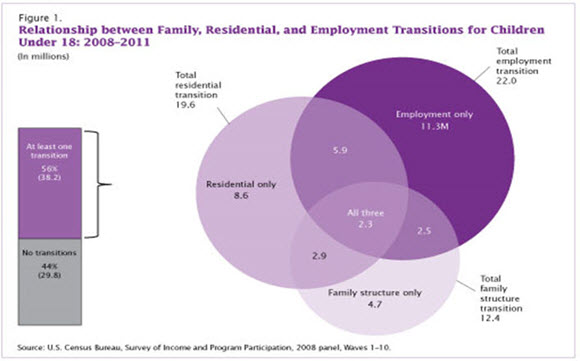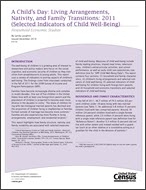
An official website of the United States government
Here’s how you know
Official websites use .gov
A .gov website belongs to an official government organization in the United States.
Secure .gov websites use HTTPS
A lock (
) or https:// means you’ve safely connected to the .gov website. Share sensitive information only on official, secure websites.
-
//
- Census.gov /
- Random Samplings /
- A Change in Circumstances: Family and Household Transitions and Child Well-Being
A Change in Circumstances: Family and Household Transitions and Child Well-Being
A Change in Circumstances: Family and Household Transitions and Child Well-Being
Change is inevitable, but how often things change can matter for the well-being of children. A new report, A Child’s Day: Living Arrangements, Nativity, and Family Transitions: 2011, uses multiyear data from the Survey of Income and Program Participation to understand how often children experience family and household transitions.
The new report examines three types of transitions that children potentially face. A family structure transition occurs if the child experienced a change in family structure due to a parent getting married, divorced or cohabiting with a new partner. An employment transition occurs if either parent in the household lost or gained a job. Lastly, a residential transition occurs if the child moved at any point.
Over half (56 percent) of children experienced at least one type of transition between 2008 and 2011. The most common type of transition that children experienced was a change in a parent’s employment status (32 percent). Family income was associated with the occurrence of a household or economic transition.
Changes in the home environment and economic resources often overlap. Figure 1 shows how often changes in family structure, residential location and parental employment coincided among children who had at least one transition between 2008 and 2011. Overall, 56 percent (38.2 million) of children experienced at least one transition.
Of the 12.4 million children who experienced a family structure transition, 4.8 million also experienced a parental employment transition (39 percent). Among children who moved(19.6 million), a higher proportion of children were more likely to have also experienced a parental employment transition (42 percent) than to have undergone a residential move and change in family structure (26 percent). Overall, 3 percent (2.3 million) of children encountered all three transitions at least once between 2008 and 2011.
Related Information
Share
 Yes
Yes
 No
NoComments or suggestions?


Top


